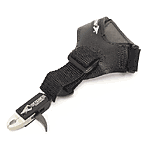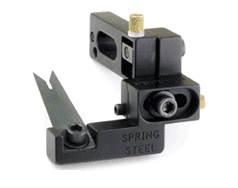THE SPORT
BOW ACCESSORIES
On both recurve and compound bows, accessories can be attached to improve their performance.
These can use aiming devices, stabilizers, vibration and noise suppressors, pull limiters, etc.
Such accessories have been present in bows since the beginning of modern competitions.
Few differences separate the allowed accessories between the two types of bows, as shown in the table below:
To learn more, click on an accessory in the list on the left...
ACCESSORY
Stabilizers
Finger guard (Finger Tabs)
Mechanical Release (Release Aid)
Sighting device (Sight)
Front sight (Apperture)
Front sight with lens (Scope)
Rear sight (Peep Sight)
Arrow Rest (Arrow Rest)
Push button (Cushion Plunger)
Clicker
CURVE
OK
OK
NO
OK
OK
NO
NO
OK
OK
OK
COMPOUND
OK
OK
OK
OK
OK
OK
OK
OK
OK
AT
STABILIZERS
A very sophisticated system used to balance and stabilize the bow. It is positioned in front of the bow and its functions are, in addition to balancing the bow during and after the shot, to absorb excessive vibrations resulting from the energy that was not used by the arrow at the moment of shooting. The main materials currently used are carbon composites and aluminum alloys. Various stabilizers of various lengths can be used on the bow.


FINGER TABS
The Finger Tab can be considered the oldest accessory of an archer. Its function is to protect the archer's fingers while drawing the bowstring. Due to the great force exerted during the pull and after repeated shots, the archer's fingers can blister or even be injured.
Basically it's made of layers of leather cut in the shape of the archer's fingers. You can also adopt the use of chin rests and finger separator.
There are several models and manufacturers that even offer synthetic materials such as Cordovan, which is waterproof.
The bowhunter may prefer to wear a three-finger glove for easier handling of the bow and arrows.



Dedeira for initiation
competition wing
3 finger hunting glove
RELEASE AID
The Release Aid is an accessory allowed only for the compound bow in competitions regulated by FITA. It is a mechanical device used to pull the bowstring and at the time of release it releases the string more cleanly, eliminating its lateral oscillation, allowing greater precision in the arrow's flight. Several types of releases are manufactured today. They may or may not have a trigger key and are divided into two groups: wrist and handheld.



wrist release,
with fire key
hand-held release,
with fire key
Back Tension release,
no fire key
AIMING EQUIPMENT
It is the device that allows the archer to adjust the height and laterality of the bow positioning at the moment of shooting.
Following the rule of arches, materials such as aluminum and carbon composites are also used in its construction, aiming to make the equipment lighter and vibration-free, as the latter is harmful to the device.
This accessory is almost always the most expensive of a bow, as its construction consists of numerous precision parts.

aiming device
SureLoc brand

APERTURE
It is the archer's visual reference for aiming. It is attached to the aiming device and its function is to position the bow towards the target.
Its shape can be square or round and it can have a central mark or not.
It can be used in both compound and recurve bows, but it is the only one allowed in the recurve bow.


Incorrect way of aiming, focusing the apperture

Correct way of aiming, focusing on the target
The aiming process in the recurve bow is done by positioning the set of aim over the target and aligning the bowstring to the Apperture, either on the left side (1-0 ), or on the right side (0-1), or by aligning the string to the bow window.
SCOPE
Accessory allowed only for the compound bow according to FITA regulations, it is fixed in front of the sight and it is through it that the archer makes his sight to aim at the target. It has a lens to enlarge the target size and a bubble level to aid vertical positioning of the bow. The power of the lens can be chosen by the archer, ranging from 2x, 4x, 6x and up to 8x magnification, with central marks in the form of dots, circles or crosses. Due to its optical quality, it becomes one of the most expensive accessories for the bow.


Scope of competition
SureLoc brand
PEEP SIGHT
According to FITA regulations, this accessory is only allowed on the compound bow.
It is attached to the bowstring e at the archer's eye level.
Its main function is to help align the rope with the sight, in addition to making the zoomed image of the target by the scope clearer.


Competition Peep Sight
Hunting Peep Sight

Target preview detail without Peep Sight

Target preview detail with Peep Sight
Note in the photo above and on the left the magnification of the target through the scope lens without the use of the peep sight, but with loss of definition of the details.
In the photo on the right, you can see that with the peep sight there is luminosity loss, but with better definition of the image details through the scope. This is due to the size of the Peep Sight hole that restricts the passage of light, improving focus.
Therefore, the smaller the Peep Sight hole, the better the image.
ARROW REST
It is a device attached to the bow window where the arrow rests before being fired. Just like the arches, the rest also uses different materials in its manufacture, which can be mechanical, magnetic, inertia or simply a single piece of injected plastic.
The illustration on the right shows traditional bows from the 70s equipped with Arrow Rests made from leather or bird feather bristles.


Arrow Rest injected plastic

Magnetic Rest Arrow


Magnetic Rest Arrow

Arrow Rest Blade for Compound Bow

Arrow Rest with spring action for compound bow

Inertial Arrow Rest for Compound Arc
CUSHION PLUNGER
Also known as Button, its function is to position the arrow in the center of the bow window and equalize its bending movement during shooting. It consists of an internal spring and a feeler that touches the arrow laterally in the first moments of the shot.
At the moment of release, the rope undergoes great lateral oscillation due to contact with the archer's fingers. Such oscillation is also applied to the end of the arrow where it is attached to the string causing the so-called “SPINE” movement.


Detail of the internal mechanism of a Button

CLICKER
Used almost exclusively in the recurve bow, this small device is used as a reference for the length of the archer's draw allowing the same force to be applied to the arrow each time the shot is made.

When pulling the bowstring, the clicker that is positioned over the arrow when reaching the end of the tip, hits the bow producing a clicking sound

